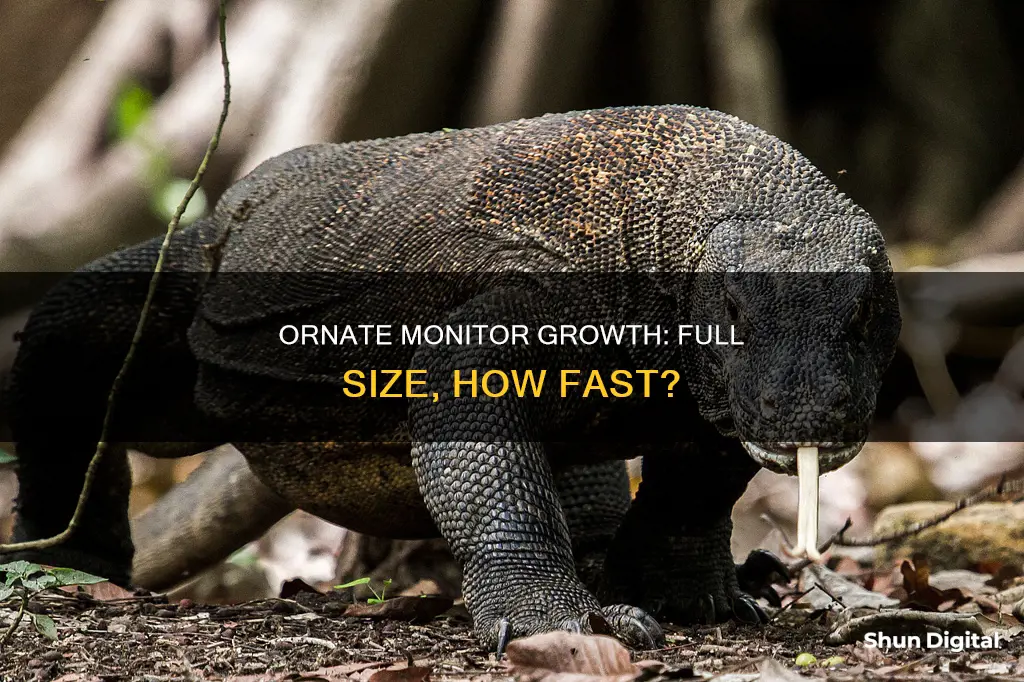
The ornate monitor (Varanus niloticus ornatus) is a monitor lizard species native to West and Middle Africa. They are quite large and can grow up to 2 meters in length. In this text, we will explore how fast these monitor lizards grow and reach their full size, as well as provide information on their habitat and diet.
| Characteristics | Values |
|---|---|
| Common Name | Ornate Monitor |
| Scientific Name | Varanus ornatus or Varanus niloticus ornatus |
| Size | Up to 2 meters in length |
| Weight | Up to 10,000 g |
| Native Region | West and Middle Africa |
| Habitat | Lowland rainforests, near watercourses |
| Diet | Crabs, insects, centipedes, small rodents, birds' eggs, sea turtle eggs, carrion |
| Lifespan | 10 to 20 years in captivity |
| Tongue Colour | Pink |
| Number of Ocelli Bands on Body | 4 or 5 |
| Behaviour | Diurnal, active year-round, excellent climber and swimmer |
What You'll Learn

Ornate monitors can grow up to 2 metres in length
The ornate monitor (Varanus ornatus) is a species of monitor lizard native to the lowland rainforests of West Africa. These large lizards can grow up to impressive lengths of 2 metres, with some sources stating that they can even exceed 6 feet in length. The size of their enclosure is crucial to their growth, as they require ample space to thrive.
The growth rate of ornate monitors can vary, with some individuals reaching 6 feet within the first 2 years of life. However, it is important to note that growth rates can be influenced by various factors, such as diet and husbandry. For example, a healthy diet for ornate monitors typically consists of crabs, insects, centipedes, and small rodents, which provide the necessary nutrients for their development.
The tongue colour is a distinct feature of ornate monitors, with a pink tongue setting them apart from the Nile monitor's dark blue or purple-blue tongue. Additionally, ornate monitors have thicker necks, wider heads, and larger, bolder markings on their bodies. Their heftier build, particularly in the head and neck region, is another notable characteristic that distinguishes them from other monitor species.
The care and handling of ornate monitors require experience and caution due to their aggressive nature. They are not typically considered tame animals, and their powerful size and strength demand respect. It is essential to provide them with specific husbandry and a suitable environment to ensure their well-being and allow them to reach their full potential in terms of size and health.
In conclusion, ornate monitors are impressive lizards that can grow up to 2 metres in length. Their size, coupled with their stocky build and bold markings, makes them stand out among other monitor species. Proper care and attention to their dietary and enclosure needs are crucial to support their growth and overall health.
Monitor Sizes: Bezels Included or Not?
You may want to see also

They are native to West and Middle Africa
The ornate monitor (Varanus niloticus ornatus) is a monitor lizard native to West and Middle Africa. They live in lowland rainforests and closed-canopy forests. They are part of the subgenus Polydaedalus, which also includes the Nile Monitor, the Savannah Monitor, and other monitors.
The ornate monitor is a large lizard species, growing up to 2 meters in length. They have a dark olive green to black back, with cross-bands of yellow or cream-colored ocelli, and additional bands on their tail. The ventral side is yellowish with grey banding. The number of ocelli bands on the body, four or five, distinguishes the ornate monitor from the Nile monitor, which has six to nine bands. These markings fade as the lizard matures.
In terms of diet, ornate monitors feed on crabs, insects, centipedes, and small rodents. They are known for their stockier build compared to other monitor lizards, particularly in the head region. The tongue of an ornate monitor is pink, in contrast to the dark blue or purple-blue tongue of a Nile monitor.
While some sources state that the ornate monitor is a separate species from the Nile monitor, recent molecular analyses challenge this classification. These studies suggest that the ornate monitor may be an informal term for forest forms of two different species of Nile monitors: Varanus stellatus (West African Nile monitor) and Varanus niloticus.
IPS Panel Monitors: ASUS' Display Innovation Explained
You may want to see also

They are considered informal forest forms of the Nile monitor species
The ornate monitor (Varanus niloticus ornatus) is a monitor lizard species native to West and Middle Africa. They are considered informal forest forms of the Nile monitor species. While they were once considered a subspecies of the Nile monitor, they are now recognised as separate species.
The Nile monitor species include Varanus niloticus (Nile monitor) and Varanus stellatus (West African Nile monitor). Comprehensive molecular analyses have shown that the ornate monitor is a synonym of Varanus niloticus and is an informal term for forest forms of either species.
There are several ways to distinguish ornate monitors from Nile monitors. Firstly, ornate monitors have a pink tongue, while Nile monitors have a dark blue or purple-blue tongue. Secondly, ornate monitors have around five bands of spots between their shoulders and hips, while Nile monitors have around seven bands. The spots of ornate monitors are generally larger and fewer, with bolder markings compared to the finer and more delicate patterns of Nile monitors. Thirdly, ornate monitors are heftier and stockier lizards, with a more massive head compared to the relatively slender Nile monitors.
Ornate monitors are quite large and can grow up to two metres in length. They are native to closed-canopy forests in West and Middle Africa, where they feed on crabs, insects, centipedes, and small rodents.
Monitoring Water Usage: Baltimore County's Conservation Efforts
You may want to see also

Ornate monitors are excellent climbers and swimmers
The ornate monitor (Varanus niloticus ornatus) is a monitor lizard native to West and Middle Africa. It is an excellent climber and swimmer.
In the wild, ornate monitors live in lowland rainforests, close to watercourses. They are typically found near beaches, mangroves, plantations, and suburban areas. Their diet consists of crabs, insects, centipedes, small rodents, birds' eggs, sea turtle eggs, and carrion.
As for their size, ornate monitors can grow up to two meters in length. They have sturdy bodies, with particularly large heads. Their tongues are pink, and their backs are dark olive green to black, adorned with crossbands of yellow or cream-colored ocelli.
The climbing and swimming abilities of ornate monitors are impressive. Their sturdy build and strong limbs enable them to climb trees and navigate through their rainforest habitat with ease. Their swimming skills are also well-adapted to their environment, allowing them to move through watercourses and mangroves with agility.
The climbing abilities of ornate monitors are not just for navigation but also for seeking shelter. In the wild, ornate monitors may spend the night on tree branches, taking refuge from potential threats. Their climbing skills provide them with a vantage point to survey their surroundings and spot potential prey or dangers.
Additionally, the swimming capabilities of ornate monitors are advantageous for both hunting and escaping predators. Their aquatic skills allow them to pursue aquatic prey, such as crabs and invertebrates, and to seek refuge from predators in the water if needed.
Troubleshooting ASUS Monitor Audio Loss: Quick Fixes
You may want to see also

They can live for 10 to 20 years in captivity
The ornate monitor is a species of monitor lizard native to West and Middle Africa. It is an excellent climber and swimmer and can grow up to 2 meters in length. In captivity, ornate monitors can live for 10 to 20 years.
Captive ornate monitors require extra light and heat, with lights that should be on for 12-14 hours a day. The temperature under the basking site should be maintained at 88-92° F, and part of the habitat should be 5-10°F cooler for thermoregulation. Flat rocks are necessary for nail wear, and these can be placed alongside water containers so that nails wear down as the lizard enters and exits the water.
Hatchlings can be kept in tanks 3' long with secure screen tops, but after 6 months, they will need enclosures of at least 4' x 2'. Adults, defined as those over 2 years old, require enclosures the size of a small room: at least 12' x 4' for monitors under 48" in length and at least 15' x 5' for those exceeding 48".
The diet of ornate monitors in captivity should consist of crickets, pinkie mice, king mealworms, and larger mice for juveniles. Monitors over 3 feet long will continue to eat king mealworms but should be fed a meat mix or mice as the bulk of their diet. Various zoos feed their ornate monitors lean ground turkey supplemented with calcium carbonate and vitamins and minerals. Commercial meat-based carnivore diets can also be fed.
In terms of behaviour, females raised from hatching may be tame when kept in larger front-opening cages, and they are generally less active than males. Males, on the other hand, tend to display a higher level of responsiveness and curiosity but are less easily tamed. When kept in cages that are too small, ornate monitors may exhibit frantic flight attempts, and if these fail, they will hold their ground and tail-whip.
Monitoring Comcast Data Usage: Tips and Tricks
You may want to see also
Frequently asked questions
Ornate monitors can grow up to two meters in length. They grow quite fast, with some users reporting that their ornate monitor reached about six feet within the first two years.
Ornate monitors are quite large and can grow up to 2 meters (6.5 feet) in length.
The growth rate of ornate monitors is not well-documented, but some owners have reported that their ornate monitor reached about six feet within the first two years.
The lifespan of ornate monitors is not mentioned, but they are known to live for at least 10 to 20 years in captivity.
Ornate monitors and Nile monitors are often confused due to their similar markings. However, they are very different animals and are now recognized as separate species. One way to tell them apart is to look at their tongues: Nile monitors have dark blue or purple-blue tongues, while ornate monitors have pink tongues. Additionally, ornate monitors are generally stockier and heftier than Nile monitors, with a more massive build.







